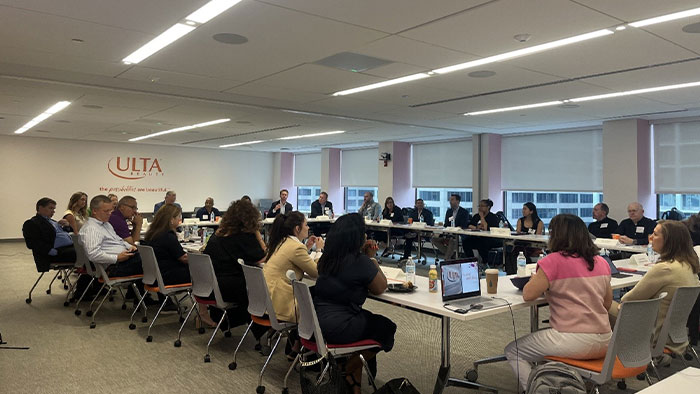Modern Approaches to Connecting with Younger Retail Workers
- By [ Devon Byrne ]
- 05/25/2023
The following is a post pulled from IRI Consultant's 2023 Labor Activity in Retail Report, released in cooperation with RILA.
ABSTRACT
The retail industry has various workforce challenges as triggered by the impact of the pandemic and the influence of labor unions creating unrest. One of the biggest challenges the industry faces is high turnover in a tight labor market, making it easy for employees to switch jobs. Notably, employees aged 16-35 account for approximately 45 percent of the retail workforce; addressing their concerns is essential to reducing turnover.
Younger workers have new perspectives on the purpose of work and employer responsibilities for health and safety and career development. To strengthen associate engagement, Ulta Beauty identified specific associate needs and responded accordingly by developing a more effective communications system, nurturing a positive workplace culture, and offering benefits that match the needs of younger people, among other strategies. Ulta Beauty also leverages digital media intelligence to inform decision making based on insights from data across the digital sphere. Through these efforts, Ulta Beauty has maintained a direct connection with team members at all levels.

Shifting From Job to Job
The younger millennials and Gen Z make up a large portion of the retail industry workforce. For this discussion, younger workers are 16-34 years old. As of 2022, the Bureau of Labor Statistics (BLS) accounted for 1.3 million people aged 16-19, 2.4 million people aged 20-24, and 3.6 million people aged 24-34 years old working in the retail industry. The industry includes grocery stores, automotive dealers, electronics stores, convenience stores, health and personal care, clothing stores, shoe stores, general merchandise stores, and more.
Every retail operation faces a common challenge: high turnover. The seasonally adjusted December 2022 retail quit rate was 3.9 percent of total employment, with accommodation and food services slightly higher at 5.4 percent. There is significant crossover between these two industries and across the different types of retail operations as employees easily move between jobs, sometimes for as little as 25-50 cents more an hour. For comparison, and to better understand the severity of this issue in retail, the total quit rate for all industries was 2.7 percent. In 2022, 617,000 people quit their retail jobs, and 745,000 quit in their job in accommodations and food services. These are also seasonally adjusted numbers, so they are statistically smoothed.
High turnover creates large costs for retailers. According to the National Bureau of Economic Research, a 10 percent higher turnover is approximately equal to a .6 percent wage increase. A 60 percent turnover rate in the retail industry equates to a 3.6 percent wage increase! Lowering turnover creates more resources for current employees and improves guest services, creating a win-win strategy.
Why Are Younger Employees Leaving Their Jobs?
The turnover rate in retail has always been high, but it is worse today because of a change in associate perspectives on employment. Three major trends have fueled this:
- During the COVID-19 pandemic, retail workers were either laid off or terminated as retail sales declined and roles were considered essential with expectations to show up for work in conditions they considered a risk to their health and safety.
- Technology continues to have a significant impact on job skills needed and the training and development required.
- Union organizing among a variety of retailers has inspired employees throughout the industry to demand an associate voice in the workplace, promoting general dissatisfaction among the workforce. If associates do not stay and organize, they leave.
McKinsey & Company took a deep dive into attrition within the retail industry. The quit rate is nearly twice the national average in other sectors. A survey of 1,000 frontline retail employees in grocery, big box retailers, restaurants, and apparel stores found that flexibility was the top driver of attrition. Associates want more control over their work schedules in addition to seeking more opportunities for career development as well as greater health and well-being support. Compensation was the fourth driver, and meaningful work the fifth.
A key point here is to recognize that only focusing on pay will not improve retention. Retail associates’ perspectives and attitudes about work’s place in their lives have changed. Employers are only rewarded with loyalty when they meet associate needs, including offering more control over their work environment. Employees want a voice in work hours and schedules, independence, and control over their work.
Following is a list of what retail employees have said they want and need:
- Attention to the things that matter in a work environment to associates
- Safety and security
- A positive culture
- Transparent communication from leadership
- Strong associate voice
- Relevant benefits
- Career planning and development
- Control over work and work schedules
- Training on new customer service technologies
- Understanding purpose relative to the company’s mission, vision, and values, which embrace social justice
Though guest service representatives and some other retail positions can work remotely, many retail workers cannot. PwC’s Global Workforce Hopes and Fears Survey found that “Workers who can’t work remotely are also far less likely than others to say they find their job fulfilling, believe that their team cares about their wellbeing, feel that they’re fairly rewarded financially or feel they can be creative in their work. As companies revisit workforce strategies, they must take into greater account these disaffected—and likely disempowered—employees.”
The PwC data also analyzed input from associates aged 18-24 who joined the workforce during the pandemic and therefore have unique perspectives. They are concerned about being overlooked for opportunities and the impact of technology and are more likely to change aspects of their working life, such as shifting employers or working hours or leaving the workforce. This survey collected responses from 52,000 workers in 44 countries and territories. Eleven percent of the respondents were Gen Zers aged 18-24, and 46 percent were Millennials aged 25-41.
Gallup’s employee engagement poll found that younger workers under 35 decreased in engagement more than others. They experienced reported declines in feeling cared about, having someone who encourages development, having opportunities to learn and grow, having opinions count, and having a best friend at work.

Tackling High Turnover With a Focus on Highest Concerns
The list of reasons associates leave for other jobs, often within a year of employment, is long, and it is difficult to address every issue at the same time. Hence, a good strategy is to focus on four major areas of highest concern for retail associates, which are the work environment, safety and security, organizational culture, which includes associate voice and leadership communication, and benefits.
Work Environment
The work environment, in general, is a broad category. It includes learning and development opportunities and career progression planning. These are spaces where retail associates feel excluded, leading to assumptions that employers do not care if they stay. The work environment also includes management’s attention to things that matter most to associates, with facility maintenance topping the list. If things are broken in stores and not prioritized, it indicates that the company doesn’t care. One prominent coffee retailers’ employees were particularly upset about in-store ice makers that broke often, forcing workers to buy ice locally. It wasn’t that they were broken; it was that they would STAY broken for weeks, months, or even years.
Safety and Security
The emphasis on safety and security accelerated during COVID and was a major reason some retail associates started organizing union efforts. Companies were caught off guard by the pandemic with poor or no protocols in place and slow responses, yet expectations for retail associates to come to work remained. Safety and security needed strengthening and that need continues today. Most retailers have experienced outside influences, including rioting and mass shootings, leading to the need for new measures to ensure workers feel safe. At Ulta Beauty, that includes cameras in stores that record 24/7/365, a guard presence in high-risk stores, and off-duty law enforcement where and when necessary.
Most think these are just loss prevention efforts, and while Organized Retail Crime (ORC) is a growing challenge both in the retail industry and at large, at Ulta Beauty, we are actually working to keep our people safe. Ulta Beauty also has a workplace violence team that is prepared to make decisions in the moment, as needed, to protect workers.
Workplace Culture
When the legendary management consultant Peter Drucker famously said, “Culture eats strategy for breakfast,” he was not saying to ignore strategy. He was underscoring the importance of an empowering culture for success. Empowering younger retail workers by paying attention to their perspective is crucial to reduce turnover and, thus, fuel organizational success. The voice of the associate is intricately tied to the effectiveness of communications.
There are different ways to approach giving associates a strong voice. Ulta Beauty has a “We Care, Let’s Talk” line, a dedicated call center where workers can express needs and challenges. Ulta Beauty’s management also conducts associate opinion surveys and develops communication action plans to address the biggest challenges faced. In our work, the most critical barrier is how associate input and the subsequent management actions are communicated to the 10-hour-a-week associate. This vital element is often neglected in retail as it is easy to assume frontline employees will recognize the changes and further explanation is not necessary. This leads to a wide communications gap, which results in low associate engagement.
Ulta Beauty hosts regular coffee chats and listening sessions. Another vital element of connecting with associates is seen in the presence of leaders in the stores. Accessibility to leadership is a key differentiator, and every member of the Ulta Beauty leadership team is approachable. Executive visits are regular and visibility is high, with executives actively working to connect with each associate during store visits. After these visits, the executives share feedback and delegate for action across departments (e.g., Operations, People Success).
Our teams conduct weekly feedback sessions that cascade from bottom to top and then top to bottom to ensure the organization is responding appropriately.
Connecting internally is often a matter of the right message for the right audience with the right digital engagement tools. Ulta Beauty has dedicated teams to communicate with store associates, corporate teams, and distribution center (DC) associates. Our intranet serves as a hub for reference, and the WorkJam app engages associates in stores and DCs. WorkJam is designed to be a way to swap shifts, etc., but when associates arrive, a world of content opens up in the app – diversity, equity, and inclusion (DE&I) efforts, associate surveys, and even micro-trainings on new products.
Two-way feedback is of the utmost importance to all associates, and even more so for younger associates. Every company should conduct a communications assessment to ensure the current channels used to engage associates are meeting associates’ needs. There should be a top-down flow of information to the frontline. And, in reverse, in-store, DC, and remote associates need to be able to initiate and provide feedback. Importantly, associate feedback requires definitive responses. It shouldn’t go into a “black hole” where it gets lost in the noise. Your leaders should always respond to associate feedback and explain the “why” of decisions, even when unable to meet associate suggestions.
Feedback should be regular, too. Gallup data show that employees who received “meaningful feedback” in the past week were four times more likely to be engaged than other employees. The key word is “meaningful,” implying it’s relevant to the moment of associate performance and not a lengthy performance review focused solely on the past. Ulta Beauty executives, managers, and frontline supervisors hold regular conversations with associates and maintain the chat line, so continuous and meaningful feedback is embedded in the organizational culture. Feedback celebrates associate successes, provides individualized information, and motivates. Feedback is also leveraged to help associates learn and grow in their jobs, supporting career development.
Benefits
Retailers can leverage benefits programs to improve associate engagement. Many offer what could be considered outdated benefits like 401(k) plans, but a younger worker might appreciate a student loan payment match more than a 401(k) match. The retailers that have experienced union organizing, like Starbucks, Amazon, and REI, were all considered “employers of choice,” but not because employees said so. The company said so. By offering what they thought workers wanted, they defined the rules of an engagement that employees were less excited about. Retailers need to ask associates which benefits matter and what challenges they are having. Don’t assume you know what associates are currently thinking or what they consider important needs.
Importance of Digital Media Intelligence
Employers should supplement direct associate-leadership communication and relationships with digital media intelligence to increase associate engagement and decrease turnover. There is a wealth of intelligence online, especially on social media accounts and employer review sites. Digital media intelligence systems and processes enable employers to listen to what associates and the public say online and take informed action as needed. This includes looking for trends, feedback, sentiment, and more.
Shopify research names the top social media platforms as Instagram, Facebook, YouTube, WhatsApp, and WeChat. However, the YPulse “TikTok Effect” trend report surveyed 13-39 year olds about social media usage and found they are obsessed with TikTok. The attraction is the short, entertaining videos that constantly change. Employers must accept that this is another forum for the associate’s voice. Dismissing it because they don’t understand or don’t like it will only leave them further disconnected from the workforce.
Ulta Beauty regards digital media intelligence as another element of the associate voice. Today’s younger workers take what they see on social media as truth. There is an element of trust in seeing a “friend” in a video, telling them to buy or to believe in something. These employees are often less trusting of a company delivering education or information, as a company is often a faceless entity.
There is much to learn through digital media intelligence, which listens across the internet, not just on social media platforms. This insight from multiple media channels works to determine the voice of stakeholders, media attention, guest experience, brand reputation, industry knowledge, competitor insights, and more. When sentiment analysis is added, organizations can monitor guest and associate feedback to understand needs better.
Younger associates use social media for union organizing, especially worker-led independent union organizing. The possibility of unionization grows stronger when younger associates believe leadership roles are theirs for the taking. When they cannot achieve that status within the workplace, the idea of forming a union gives them something to lead. The desire to be part of something, to lead a movement, is strong amongst today’s 18- to 30-year-old workers. Without a strong employee voice, employees go online to express that voice and to feel empowered. TikTok users have posted videos to support unionizing at other businesses, organizing in their own workplace and calling for product boycotts. Digital media intelligence can help detect these, helping companies meet associate needs proactively.
Engaging Associates and Lowering Turnover in the Here and Now
Like the internal associate feedback system, data collection and analysis are only effective when informed action is taken. Retailers are struggling to retain associates, and reducing turnover is challenging. It takes a coordinated, well-planned communications system to empower the associate voice and ensure safe workplaces, with Human Resources (HR) programs that support current associate needs and a culture that generates positive associate relations. There are many ways to connect with younger associates that include using technology-like apps, but don’t forget the humanizing aspect of face-to-face conversations. Ulta Beauty has found enormous success in lowering turnover rates by implementing various practices geared toward younger associates.
In retail, the trends of the workforce experience are reflected in high turnover based on a belief there is a better job always available in a tight labor market. There is no arguing that the pandemic led to changes in how retail workers view their jobs, the value of work, and the role of employers in meeting needs to gain their loyalty.
Today, the empowerment retail workers feel is supported by the trust placed in social media and a belief that independent unionizing is an option to gain a stronger voice in the workplace. Employers that maintain a direct connection with employees and lower turnover through positive associate relations recognize the environment of the retail workplace experience has changed. It is imperative to address the work environment from the perspective of the younger workers who are not interested in just trading time for money. They want safety and security, a culture of inclusion where their voices are easily expressed, career path development opportunities, benefits that are better suited for their age, and a high-quality communications system embedded with two-way feedback across communication channels.
Tags
-
Investing in People
-
Workforce


